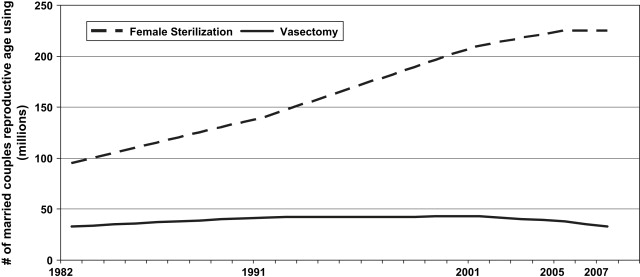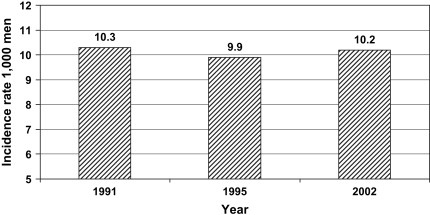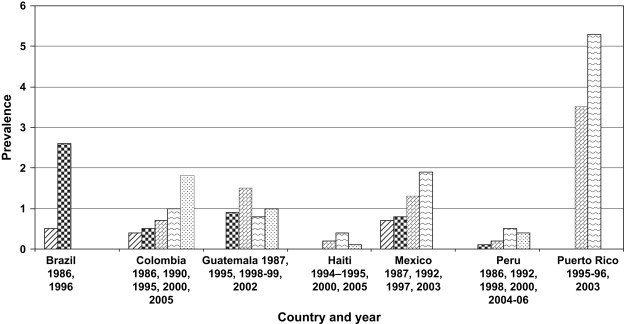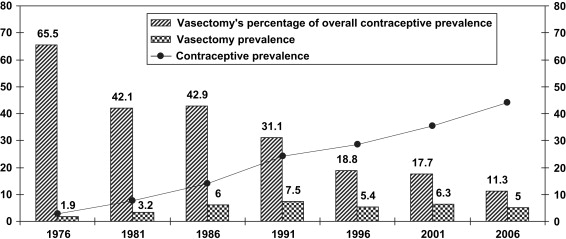Vasectomy is safer, simpler, less expensive, and equally as effective as female sterilization—yet it remains one of the least known and least used methods of contraception. Worldwide, an estimated 33 million of married women ages 15 to 49 (less than 3%) rely on their partner’s vasectomy for contraception.
Vasectomy is safer, simpler, less expensive, and equally as effective as female sterilization—yet it remains one of the least known and least used methods of contraception. Worldwide, an estimated 33 million of married women aged 15 to 49 (less than 3%) rely on their partner’s vasectomy for contraception ( Table 1 ).
| Region | Percent Married Women of Reproductive Age Using | No. of Users (Million) |
|---|---|---|
| Africa | ∼0.1 | 0.2 |
| Asia | 3 | 22.5 |
| Latin America/Caribbean | 2 | 1.9 |
| Europe | 3 | 2.9 |
| North America | 12 | 4.1 |
| Oceania | 10 | 0.5 |
| World | 2.9 | 32.8 |
Female sterilization is approximately twice as common as vasectomy in the developed world, 8 times more common in Asia, and 15 times more common in Latin America and the Caribbean. The gap is likely greater in sub-Saharan Africa; however, rates are too low for accurate comparison. Vasectomy is more common than female sterilization in only five countries—Bhutan, Canada, the Netherlands, New Zealand, and the Great Britain. In Bhutan, vasectomy is 8 times more common than female sterilization; in Great Britain, nearly 3 times as common; in Canada and the Netherlands, twice as common; and in New Zealand, approximately one third more common.
The use of vasectomy in the world varies significantly by region and country. In developed countries overall, fewer than 5% of couples rely on vasectomy. In developing countries, the overall prevalence of vasectomy is 2.5%. Prevalence exceeds 10% in eight countries—Australia, Bhutan, Canada, the Netherlands, New Zealand, the Republic of Korea, Great Britain, and the United States ( Table 2 ). Bhutan has approximately 40% of contracepting couples relying on vasectomy, the highest proportion in the world, followed by New Zealand with approximately 25%, then Canada, the United Kingdom, and the United States at approximately 20% each, and Australia and the Republic of Korea with 12.5% each.
| North America/Europe/Oceania | Asia | Americas | Africa | ||||
|---|---|---|---|---|---|---|---|
| New Zealand (1995) | 19.3 | Bhutan (2000) | 13.6 | Puerto Rico (2002) | 5.3 | Namibia (2000) | 0.8 |
| Great Britain (2007/08) | 16.0 | Republic of Korea (1997) | 12.7 | Brazil (1996) | 2.6 | South Africa (2003) | 0.7 |
| Canada (1995) | 15.2 | China (2004) | 6.7 | Mexico (2003) | 1.9 | Botswana (2000) | 0.2 |
| United States (2002) | 12.8 | Nepal (2006) | 5.0 | Colombia (2004/05) | 1.8 | Swaziland (2006/2007) | 0.2 |
| Netherlands (1993) | 10.5 | Iran (2000) | 2.8 | Guatemala (2002) | 1.0 | Central African Republic (2006) | 0.1 |
| Australia (2008) | 11.2 | Sri Lanka (2000) | 2.1 | Nicaragua (2001) | 0.5 | Democratic Republic Congo (2001) | 0.1 |
| Spain (1999) | 9.0 | Myanmar (2001) | 1.5 | Haiti (2000) | 0.4 | Mauritius (2002) | 0.1 |
| Switzerland (1994/1995) | 8.3 | India (2005/2006) | 1.0 | Peru (2004/2006) | 0.4 | Rwanda (2007/2008) | 0.1 |
| Belgium (1991) | 7.0 | Thailand (2005/2006) | 1.0 | Uruguay (2004) | 0.4 | Sao Tome and Principe (2000) | 0.1 |
| Czech Republic (1997) | 5.1 | Bangladesh (2006) | 0.6 | Honduras (2005/2006) | 0.3 | Uganda (2006) | 0.1 |
Asia, with a prevalence of 3%, accounts for approximately three fourths of the 32 million couples worldwide who use vasectomy—China and India alone account for 20 million users. In Latin America and the Caribbean the prevalence of vasectomy is only 2%. Puerto Rico has the highest rate in the region, 5.3%. In sub-Saharan Africa less than one tenth of 1% of married women rely on a partner’s vasectomy for contraception.
Trends in vasectomy prevalence
Globally, after steadily increasing in the 1990s, the number of couples relying on vasectomy has dropped back to a level seen in the early 1980s ( Fig. 1 ). In 1982, an estimated 33 million couples were protected from unintended pregnancy by vasectomy. Over the next decade, the number of couples relying on vasectomy increased by approximately 10 million, and in 1991, vasectomy protected approximately 42 million couples from unintended pregnancy. By 2001, however, the number of couples protected by vasectomy had increased by only 1 million, to an estimated 43 million couples. By comparison, the number of couples relying on female sterilization rose from approximately 140 million in 1991 to more than 210 million in 2001. By 2005, the number of vasectomy users had declined slightly to 38 million whereas the number of female sterilizations had risen to 225 million. The most recent estimate (from 2007) suggests that the number of vasectomy users has dropped to 33 million whereas the number of female sterilization users has remained constant at 225 million. Global estimates of contraceptive use are based on national surveys of women of reproductive age, typically aged 15 to 49. Estimates of the prevalence of vasectomy have declined over the past few years as older age cohorts (married women 35 and older) that were more likely to rely on vasectomy have “aged out” of their reproductive years and much larger younger age cohorts (<15) have “aged in.” As a result, although overall vasectomy prevalence seems to have declined, in many countries the actual incidence number of procedures performed annually is increasing.

Vasectomy in the United States, Canada, and Other Developed Countries
There is no nationwide surveillance or reporting in place for systematically gathering information on vasectomy incidence or prevalence in the United States. Rather, this information must come from periodic survey or specific research studies. After increasing steadily during the 1960s and 1970s, the rate of vasectomy in the United States leveled off during the 1980s and has remained stable ever since. In 1991 and 1995, approximately 500,000 vasectomies were performed in the United States. Although the estimated number performed in 2002, the most recent year for which data are available, was slightly higher at 526,501, the incidence rate has remained unchanged between 1991 and 2002 at approximately 10 per 1000 men aged 25 to 49 ( Fig. 2 ). These findings are consistent with results from the National Survey of Family Growth (NSFG)—a periodic survey conducted by the National Center for Health Statistics—indicating that the proportion of women reporting their partner had a vasectomy has remained relatively constant since the late 1980s.

In 2002 (the most recent cycle of the NSFG), vasectomy was reported as the fourth most commonly used method (after oral contraceptives, tubal sterilization, and condoms) among women in the United States aged 15 to 44—5.7% reported they relied on their partner’s vasectomy for contraception. For the first time, in 2002, the NSFG included interviews with men aged 15 to 44; 6.2% reported having had a vasectomy. There were wide variations in men’s reported use of vasectomy by age, rising from 1.6% to 9.3% from ages 25 to 39 and then increasing dramatically to 18.8% among men 40 to 44 years old.
There is a large gap in sterilization use between women and men in the United States, with 3 times as many women sterilized than men. Although 16.7 % of women 15 to 44 years old reported female sterilization as their current contraceptive, only 5.7% reported male sterilization. Although the difference decreases among married couples, there are still more than 1.5 times as many couples using female sterilization compared to vasectomy (21.3% versus 12.8%, respectively). There is a wide range of vasectomy prevalence among individual states, ranging from a prevalence of less than 5% in Hawaii, New Jersey, and the District of Columbia to a prevalence of greater than 17% in Idaho, Oregon, Washington, and Vermont ( Table 3 ).
| <5 | 5 to <10 | 10 to <15 | 15+ | ||||
|---|---|---|---|---|---|---|---|
| Hawaii | 4.9 | Illinois | 9.8 | Wisconsin | 14.9 | Idaho | 19.9 |
| New Jersey | 4.7 | Virginia | 9.3 | Wyoming | 14.5 | Washington | 18.5 |
| Guam | 3.9 | Maryland | 9.2 | Colorado | 14.4 | Vermont | 17.5 |
| U.S. Virgin Islands | 2.1 | California | 8.8 | Maine | 14.3 | Oregon | 17.2 |
| District of Columbia | 1.5 | Delaware | 8.7 | Indiana | 14.2 | Minnesota | 16.8 |
| — | — | West Virginia | 8.2 | North Dakota | 14.2 | Montana | 16.8 |
| — | — | Tennessee | 8.1 | Alaska | 13.8 | New Hampshire | 16.1 |
| — | — | Nevada | 8.1 | Ohio | 13.7 | Michigan | 15.7 |
| — | — | Georgia | 7.9 | Nebraska | 13.3 | Iowa | 15.0 |
| — | — | Massachusetts | 7.9 | Kansas | 13.0 | — | — |
| — | — | North Carolina | 7.2 | Arkansas | 12.5 | — | — |
| — | — | Alabama | 7.0 | Oklahoma | 12.4 | — | — |
| — | — | Kentucky | 7.0 | South Dakota | 11.7 | — | — |
| — | — | New York | 6.9 | Arizona | 11.5 | — | — |
| — | — | South Carolina | 6.9 | Missouri | 11.2 | — | — |
| — | — | Florida | 6.8 | Utah | 10.9 | — | — |
| — | — | Louisiana | 6.7 | New Mexico | 10.4 | — | — |
| — | — | Texas | 6.6 | Rhode Island | 10.2 | — | — |
| — | — | Mississippi | 5.8 | Connecticut | 10.1 | — | — |
| — | — | Puerto Rico | 5.4 | Pennsylvania | 10.1 | — | — |
Unlike the United States, Canada provides universal health care, and vasectomy is provided to men free of charge through the national health insurance program. It is, therefore, possible to estimate the number of vasectomies performed in Canada using fee-for-service utilization data from the Canadian National Physician Database. According to the most recent report, during 2005 to 2006, approximately 60,908 vasectomies were done in Canada. Using data from the 2006 Canadian census, this translates approximately to a rate of 11 per 1000 men aged 25 to 49. The sterilization usage patterns in Canada show a pattern opposite to that seen in the United States, with more than twice as many men vasectomized than women having had a tubal sterilization in 2005 to 2006 (approximately 60,908 vasectomies versus 27,309 tubal sterilizations).
In Great Britain, the Office for National Statistics conducts annual surveys on contraceptive use among women aged 16 to 49 and men aged 16 to 69. In 2007 to 2008, 16% of all men under 70 years old reported they had a vasectomy and 13% of women reported their partner was sterilized. Among married women, 19% stated their husband had had a vasectomy. Thirty percent of men over age 50 who were interviewed reported having had a vasectomy. The procedure is available free of charge through the National Health Service. The percentage of vasectomies performed by the National Health Service has increased significantly in the past decade, rising from 66% in 20001 to 2002 to 74% in 2007 to 2008.
New Zealand has the highest vasectomy prevalence in the world, 19.3%. Widely used since the 1970s, its prevalence surpassed that of female sterilization in the mid-1980s. In the late 1990s a telephone survey found that more than half (57%) of men aged 40 to 49 had had vasectomies. The procedure is popular among all socioeconomic groups. In Australia, vasectomy has increased steadily in popularity since the early 1970s when the Australian Medical Association dropped its opposition to the method.
Vasectomy in Latin America and the Caribbean
Vasectomy use in Latin America and the Caribbean has increased 60-fold in the past 25 years, fourfold in the past 15 years. In 1983, only 30,000 couples were using vasectomy in the region. By 1991, that number had increased to 400,000. In 2007, an estimated 1.9 million couples of reproductive age relied on vasectomy. Nevertheless, the prevalence remains less than 1% in much of the region, the exceptions being Brazil, Colombia, Guatemala, and Mexico, countries that had programs that benefited from significant donor support for vasectomy services in the 1980s and early 1990s ( Fig. 3 ).

Vasectomy in Asia
In Asia, vasectomy played a dominant role in the early years of many national family planning programs. In the 1960s and 1970s vasectomy was heavily promoted in Bangladesh, India, Nepal, and the Republic of Korea, and it was not until the late 1970s that female sterilization began to outpace vasectomy. In Nepal, as alternative methods have become available over the past 30 years, vasectomy’s percentage of overall contraceptive prevalence has declined from 66% in 1976 to 11% in 2006 ( Fig. 4 ).









